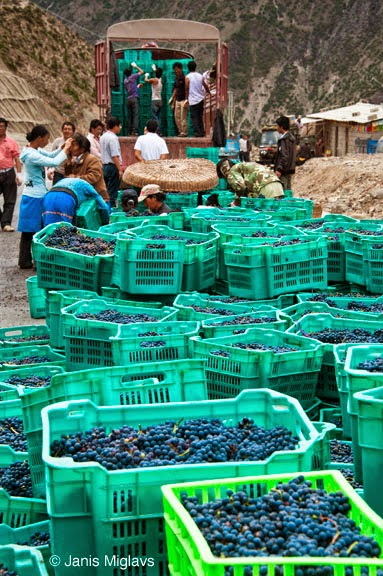Originally, through special arrangements with the local government, Shangri-La winery, a division of Chinese conglomerate liquor maker VATS Group, was able to contract with local farmers to grow grapes on the tiny flat terraced plots of land.
In spite of the rugged land and transportation difficulties, French spirits maker Moet Hennessy saw the positive climate and soil as great potential to grow quality wine grapes in this remote part of Yunnan.
As a result, Moet Hennessy partnered with VATS Group's Shangri-La winery to form Moet Hennessy Shangri-La (Deqin) Winery Co.
 |
| The vineyard terraces are steep in the western part of Yunnan Province near the Tibet border. These farmers contract with Moet Hennessy Shangri-La (Deqin) Winery Co. to provide wine grapes. |
 |
| Moving harvested wine grapes to collection points for Moet Hennessy Shangri-La (Deqin) Winery is no easy task in this far western part of Yunnan Province. China wine. |
 |
| Cabernet sauvignon and Merlot are the most popular varieties for the conservative thinking farmers in this far western part of Yunnan Province near the Tibetan border. China wine. |
 |
| Each crate loaded with Cabernet sauvignon grapes weighs about 20 kilos or about 44 pounds. China wine. |
 |
| Again, each crate loaded with Cabernet sauvignon grapes weighs about 20 kilos or about 44 pounds. This man is shorter and more slightly built than I am. China wine. |
 |
| The farmers use any available vehicle, including dump trucks to bring the harvest to the Moet Hennessy Shangri-La (Deqin) Winery collection area. China wine. |
 |
| The Shangri-La Winery general manager/vineyard manager must constantly teach the farmers what makes a quality grape that will bring the highest price. Yunnan Province, China. |
 |
| While I saw these geese feed on insects, never once did they steel a ripe Cabernet sauvignon grape. Yunnan Province, China. |
All images copyright ©Janis Miglavs 2014







